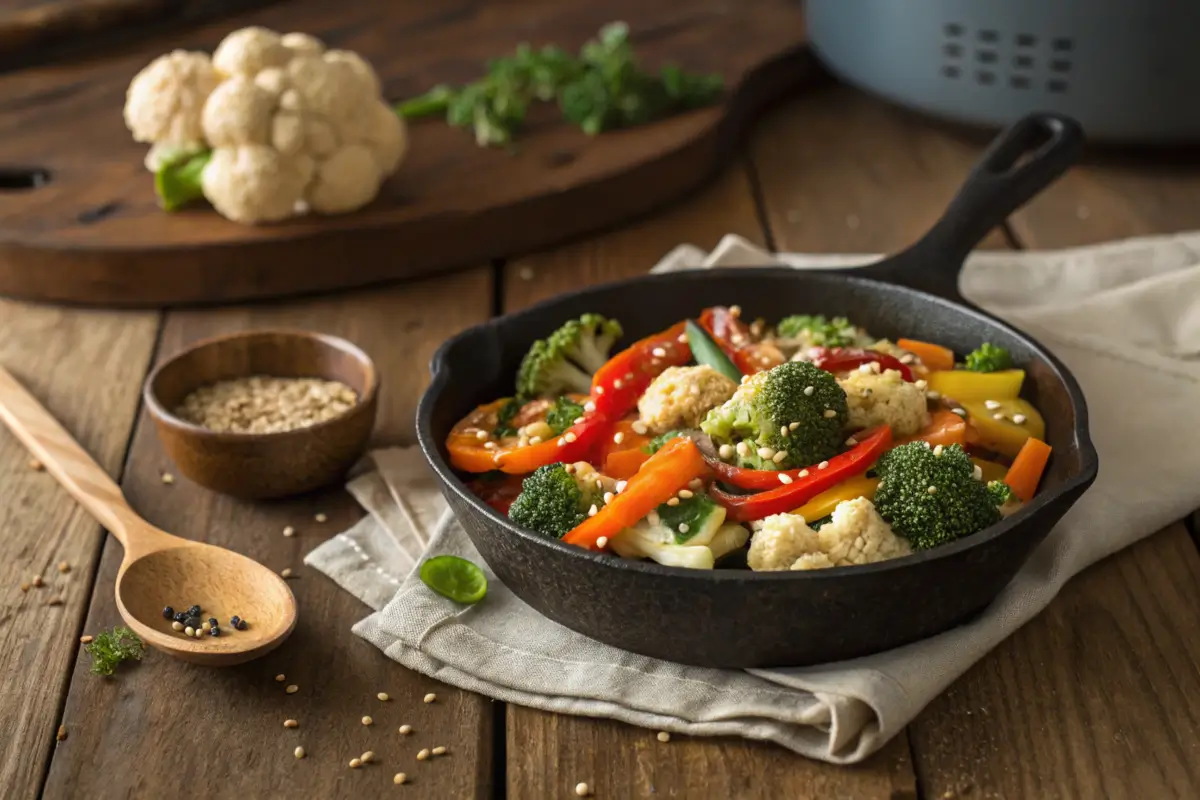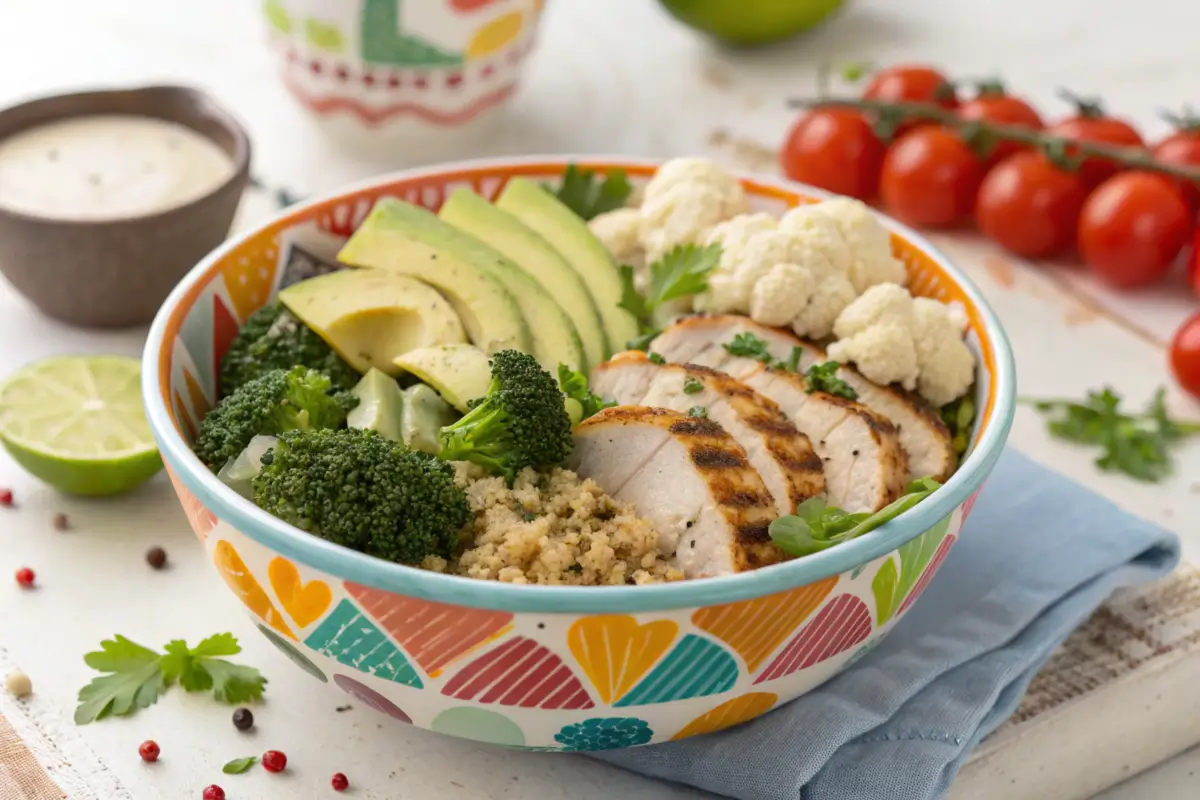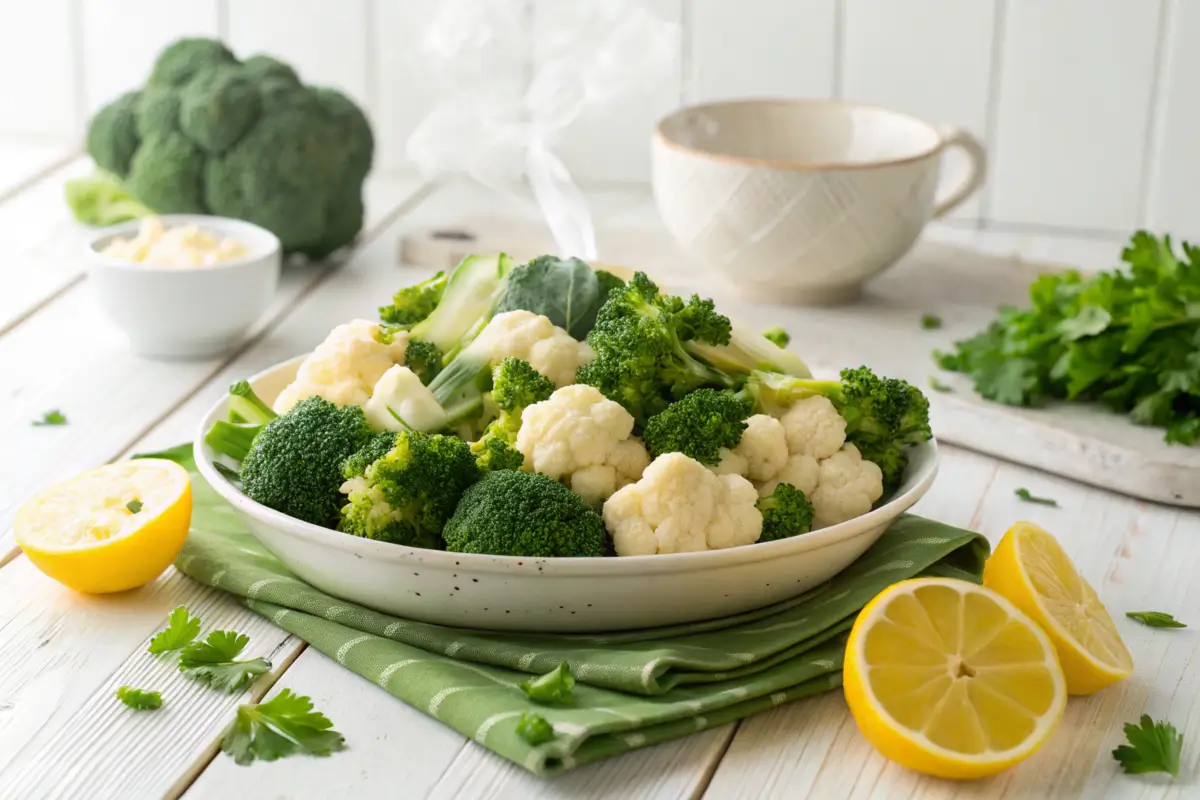Broccoli and cauliflower are not just side dishes—they’re nutrition powerhouses loaded with vitamins, minerals, and antioxidants. These cruciferous vegetables are incredibly versatile and can be prepared in ways that maximize both their taste and health benefits. But what is the healthiest way to eat broccoli and cauliflower? This guide dives into their nutritional profiles, optimal cooking methods, and creative recipes to ensure you’re getting the most out of these vibrant veggies.
Understanding the Nutritional Profiles of Broccoli and Cauliflower
Nutrient Composition of Broccoli
Broccoli is a superstar when it comes to nutrients. Packed with vitamin C, vitamin K, fiber, and folate, it offers a wide array of health benefits. One cup of broccoli provides nearly 135% of the daily recommended intake of vitamin C—boosting your immune system and improving skin health. It also contains sulforaphane, a powerful compound that may help combat cancer by neutralizing harmful toxins in the body.
Beyond vitamins, broccoli delivers about 2.6 grams of protein per cup. It’s a surprising source of plant-based protein for vegetarians and vegans alike. Plus, its fiber content promotes better digestion and supports gut health.
Nutrient Composition of Cauliflower
Cauliflower may look unassuming, but don’t let its pale exterior fool you. It’s just as nutrient-dense as its green cousin. When considering what is the healthiest way to eat broccoli and cauliflower, it’s clear that cauliflower deserves a place on your plate. This veggie is an excellent source of vitamin C and B vitamins like folate and pantothenic acid. A single cup contains about 77% of the daily value for vitamin C, helping fight inflammation and boosting overall well-being.
Cauliflower also contains glucosinolates and isothiocyanates—plant compounds known for their antioxidant properties. It’s rich in choline, a nutrient that supports brain health, and provides roughly 2 grams of protein and 3 grams of fiber per cup, making it a low-calorie, high-fiber option for any meal.
Comparative Analysis
When comparing broccoli and cauliflower, they share many similarities: both are low in calories, high in fiber, and rich in phytonutrients. However, broccoli edges out slightly with its higher levels of vitamins A and K, while cauliflower shines in its choline content.
In short, including both in your diet ensures you’re reaping a diverse array of essential nutrients. Whether you’re aiming to boost immunity, improve digestion, or promote overall health, these vegetables have got you covered.
Health Benefits of Consuming Broccoli and Cauliflower
Antioxidant Properties
Broccoli and cauliflower are rich in antioxidants, which help combat oxidative stress in the body. These antioxidants neutralize free radicals, reducing cell damage and lowering the risk of chronic diseases. Notably, broccoli contains sulforaphane, a compound renowned for its antioxidant and anti-inflammatory properties. Cauliflower, too, is packed with vitamin C, enhancing its antioxidant capacity.
Cancer Prevention Potential
Regular consumption of cruciferous vegetables like broccoli and cauliflower has been linked to a reduced risk of certain cancers. The glucosinolates in these vegetables break down into compounds that may inhibit cancer cell growth. Studies suggest that sulforaphane in broccoli can hinder the progression of cancer cells, particularly in prostate cancer. Including these vegetables in your diet could be a proactive measure against cancer development.
Digestive Health Advantages
Dietary fiber is essential for a healthy digestive system, and both broccoli and cauliflower are excellent sources. Fiber adds bulk to the stool, facilitating regular bowel movements and preventing constipation. Additionally, a high-fiber diet supports a diverse and thriving gut microbiome, which is crucial for overall health. Incorporating these fiber-rich vegetables can promote better digestion and gut health.
Optimal Cooking Methods to Preserve Nutrients
Steaming
Steaming is one of the best methods to cook broccoli and cauliflower while preserving their nutrients. This gentle cooking technique minimizes nutrient loss, especially for water-soluble vitamins like vitamin C. To steam, place the vegetables in a steamer basket over boiling water for about 5 minutes until they are tender-crisp. This method retains the vibrant color and crunch, making your meal both nutritious and appealing.
Microwaving
Microwaving is another excellent way to cook these vegetables without significant nutrient loss. The short cooking time and minimal water usage help preserve vitamins and antioxidants. Place chopped broccoli or cauliflower in a microwave-safe dish with a small amount of water, cover, and cook on high for 3-4 minutes. Be cautious not to overcook, as this can lead to nutrient degradation.
Avoiding Boiling
Boiling broccoli and cauliflower can lead to substantial nutrient loss, as water-soluble vitamins leach into the cooking water. For instance, boiling can cause up to a 70% reduction in vitamin C content. If you prefer boiling, consider using the leftover cooking water in soups or sauces to reclaim some of the lost nutrients. However, opting for steaming or microwaving is generally better to maintain their health benefits.
Understanding the healthiest ways to eat broccoli and cauliflower involves not only recognizing their health benefits but also choosing cooking methods that preserve their valuable nutrients. By incorporating these practices into your meal preparation, you can maximize the health advantages these cruciferous vegetables offer.
Creative and Healthy Recipes Incorporating Broccoli and Cauliflower
Broccoli and Cauliflower Stir-Fry
Looking for a quick, nutritious meal? Try a broccoli and cauliflower stir-fry. This dish combines these cruciferous vegetables with a medley of colorful veggies, providing a fiber-rich, antioxidant-packed meal. To prepare, heat a tablespoon of olive oil in a pan, add minced garlic, and sauté until fragrant. Toss in bite-sized pieces of broccoli and cauliflower, along with sliced bell peppers and carrots. Stir-fry for 5-7 minutes until tender-crisp. Finish with a splash of low-sodium soy sauce and a sprinkle of sesame seeds. Serve over brown rice or quinoa for a balanced, plant-based meal.
Roasted Broccoli and Cauliflower with Herbs
Roasting enhances the natural flavors of broccoli and cauliflower, making them irresistibly delicious. Preheat your oven to 425°F (220°C). On a baking sheet, toss florets of broccoli and cauliflower with olive oil, minced garlic, and a mix of dried herbs like thyme and rosemary. Season with salt and pepper. Roast for 20-25 minutes, stirring halfway through, until golden and tender. This simple yet flavorful side dish pairs well with grilled proteins or can be added to salads for an extra nutrient boost.
Cauliflower Rice and Broccoli Salad
For a low-carb alternative, consider a cauliflower rice and broccoli salad. Start by pulsing cauliflower florets in a food processor until they resemble rice grains. Lightly sauté the cauliflower rice in a pan with olive oil for 5 minutes. In a large bowl, combine the cauliflower rice with chopped raw broccoli, diced red onions, cherry tomatoes, and cucumbers. Dress with a lemon-tahini dressing made from tahini, lemon juice, garlic, and water to reach desired consistency. This refreshing salad is perfect for meal prep and stays well in the fridge for up to three days.

Frequently Asked Questions
Is it better to eat broccoli and cauliflower raw or cooked?
Both raw and cooked broccoli and cauliflower offer health benefits. Eating them raw provides higher levels of certain nutrients like vitamin C, which can degrade with heat. However, cooking, especially steaming, can enhance the availability of antioxidants like sulforaphane. To maximize benefits, include both raw and cooked forms in your diet.
How can I enhance the flavor of steamed broccoli and cauliflower without adding unhealthy fats?
To boost flavor without unhealthy fats, season steamed vegetables with fresh herbs, lemon zest, or a sprinkle of nutritional yeast. A dash of balsamic vinegar or a drizzle of tahini can also add depth without compromising health.
Are there any potential side effects of consuming these vegetables in large quantities?
While broccoli and cauliflower are healthy, consuming them in large amounts may cause gas or bloating due to their high fiber content. Gradually increasing intake and cooking them can help minimize digestive discomfort.
How should I store broccoli and cauliflower to maintain their freshness and nutrient content?
Store unwashed broccoli and cauliflower in the refrigerator’s crisper drawer, wrapped loosely in plastic or in perforated bags. This method maintains freshness and nutrient content for up to a week. Avoid washing before storage, as moisture can promote spoilage.
Incorporating broccoli and cauliflower into your meals not only adds variety but also boosts nutritional intake. By exploring different cooking methods and recipes, you can enjoy these vegetables in diverse and delicious ways.
Sustainable Practices for Buying and Using Broccoli and Cauliflower
Choosing Locally Grown Produce
When considering what is the healthiest way to eat broccoli and cauliflower, it’s important to think beyond nutrition and cooking methods. Choosing locally grown produce supports sustainability while ensuring fresher, more nutrient-dense vegetables. Locally sourced broccoli and cauliflower often have fewer food miles, meaning they retain more vitamins and minerals compared to those that travel long distances.
Visit your local farmers’ market or join a community-supported agriculture (CSA) program to get high-quality, fresh broccoli and cauliflower. By doing so, you reduce your environmental footprint and support local farmers.
Reducing Food Waste
Reducing waste is key to sustainable eating. Start by using the entire vegetable, including stems and leaves. Broccoli stems can be sliced and added to stir-fries or soups, while cauliflower leaves make an excellent addition to salads or can be roasted for a crispy side.
Store vegetables properly to extend their shelf life. As mentioned earlier, keep them unwashed in the fridge, and if they start to wilt, incorporate them into cooked dishes rather than throwing them away. By using all parts of these vegetables, you maximize their value and minimize waste.
Common Mistakes to Avoid When Preparing Broccoli and Cauliflower
Overcooking
One of the biggest mistakes people make with broccoli and cauliflower is overcooking them. When overcooked, these vegetables lose their bright color, crisp texture, and valuable nutrients, particularly vitamin C and antioxidants. Steaming for too long or boiling until mushy not only diminishes their health benefits but also results in an unappealing taste.
To avoid overcooking, aim for tender-crisp vegetables. For steaming, 5-7 minutes is generally sufficient, while roasting requires about 20 minutes at 425°F. Always check for doneness with a fork.
Skipping Proper Seasoning
Broccoli and cauliflower are nutritious, but they can taste bland if not seasoned well. Some cooks forget that simple seasonings like garlic, lemon juice, or olive oil can dramatically enhance flavor. Experimenting with spices like turmeric, paprika, or cumin can also elevate their taste while adding health benefits.
Using Too Much Oil or Fat
While it’s tempting to drench these vegetables in butter or heavy dressings, this can negate their health benefits. Opt for healthier fats like olive oil in moderation. A light drizzle is sufficient to bring out their natural flavors without adding unnecessary calories.
Ignoring the Nutritional Potential of Raw Vegetables
Although cooking enhances certain compounds, raw broccoli and cauliflower retain more vitamin C and some other nutrients. Incorporating them into raw dishes like salads or slaws ensures you get a balance of benefits. Don’t overlook the potential of these crunchy, nutrient-dense options.
By embracing sustainability and avoiding common cooking pitfalls, you can truly unlock the potential of these powerhouse vegetables. Implementing these tips ensures you’re eating broccoli and cauliflower in the healthiest, most delicious ways possible.
Pairing Broccoli and Cauliflower with Other Foods for Maximum Nutrition
Combining with Protein Sources
When exploring what is the healthiest way to eat broccoli and cauliflower, consider pairing them with protein-rich foods. Combining these vegetables with lean proteins like grilled chicken, tofu, or lentils creates a well-rounded, nutrient-dense meal. For instance, a stir-fry with broccoli, cauliflower, and chicken provides a perfect balance of vitamins, fiber, and protein.
Legumes, such as chickpeas or black beans, are another excellent choice. Toss roasted broccoli and cauliflower with a handful of chickpeas for a hearty salad or side dish. This combination offers not only complementary textures but also an impressive nutritional profile.

Adding Healthy Fats
Healthy fats enhance the absorption of fat-soluble vitamins like vitamin K in broccoli. Drizzle olive oil over roasted cauliflower or sprinkle avocado slices onto a broccoli salad to boost the dish’s nutritional benefits. Nuts and seeds, such as almonds or sunflower seeds, also make great additions, adding crunch and omega-3 fatty acids.
Pairing these vegetables with fats not only enhances their taste but also helps your body absorb their nutrients more effectively. For a simple and healthy dip, try blending avocado with a touch of garlic and lime for a creamy topping.
Incorporating Broccoli and Cauliflower into Daily Meals
Breakfast Ideas
Start your day with a boost of nutrients by including broccoli or cauliflower in your breakfast. Add steamed broccoli to an omelet or frittata along with onions, peppers, and your favorite herbs. Alternatively, blend cooked cauliflower into a smoothie for a creamy texture without overpowering the flavor. It’s a great way to sneak in vegetables early in the day.
For those who enjoy savory breakfasts, cauliflower hash is a tasty alternative to traditional potato hash. Sauté grated cauliflower with onions, garlic, and a touch of olive oil for a satisfying morning meal.
Lunch and Dinner Options
Incorporating broccoli and cauliflower into lunch and dinner is easy and versatile. For lunch, consider a warm broccoli and quinoa bowl drizzled with tahini dressing. Add roasted chickpeas or grilled tofu for protein, creating a balanced, filling dish.
For dinner, use cauliflower rice as a base for stir-fries or curries. This low-carb option absorbs flavors beautifully, making it ideal for dishes with bold spices and sauces. Broccoli can also shine as a topping for baked sweet potatoes or as a hearty side dish alongside grilled salmon.
These ideas demonstrate that what is the healthiest way to eat broccoli and cauliflower extends beyond health benefits—it’s about integrating these powerhouse vegetables seamlessly into your daily meals for optimal taste and nutrition.
By focusing on pairings and creative meal ideas, these sections highlight how broccoli and cauliflower can elevate your everyday eating habits while ensuring maximum health benefits.

